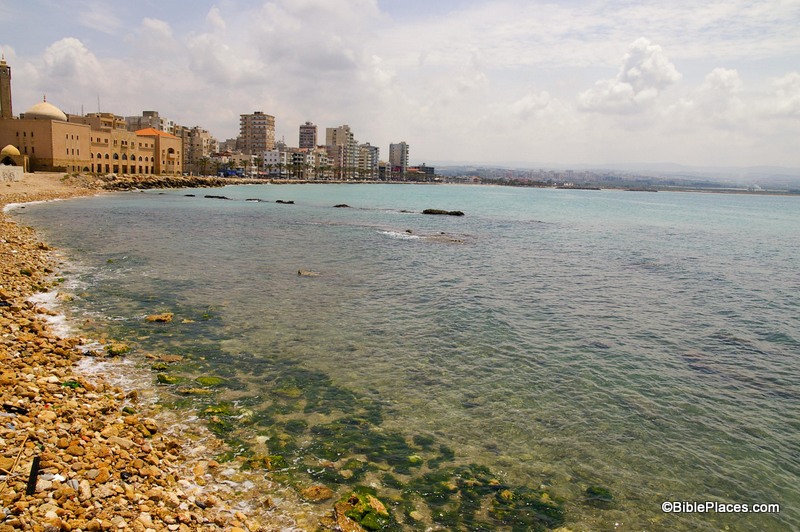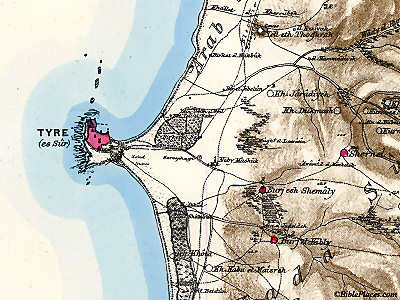(Post by Seth M. Rodriquez)
At first glance, our picture of the week looks like a peaceful, pleasant Mediterranean beach. However, there is more here than meets the eye. This is the site of a famous battle waged by Alexander the Great, and the place still bears the marks of Alexander’s army. In fact before 332 B.C., this beach didn’t even exist.
In antiquity, the city of Tyre was comprised of a fortified settlement on the mainland and another settlement on an island about half a mile off the coast. What you are looking at is the southern side of the isthmus that was created when Alexander’s army built a causeway between the mainland and the island. The image below from the maps of the Survey of Western Palestine provides a bird’s eye view of the former island with the narrow isthmus. (These maps are available here in digital form for only $35.)
The Wycliffe Historical Geography of Bible Lands describes the confrontation between the inhabitants of Tyre and Alexander the Great in this way:
Tyre alone opposed Alexander. The Tyrians initially offered submission and tribute to him, thinking they would thereby gain substantial freedom, as they had before. But when they saw that Alexander intended personally to occupy the city, they determined to resist.
Hope of Tyrian success in withstanding the siege was not unfounded. Their city was located on an island a half mile from shore; the current in the channel which separated it from land was swift. Their fleet controlled the sea. The city wall on the landside rose to 150 feet. There were assurances of help from Carthage and elsewhere. But Alexander devised unexpected tactics. He resolved to construct a causeway 200 feet wide out to the island, on which he could plant his siege engines. Ruins of mainland Tyre furnished material for the causeway. The Tyrians fought heroically. They destroyed the engines of war by fire-ships and damaged the mole, or causeway. They hurled pots of burning naphtha, sulfur, and red-hot sand from catapults. Seeing that the battle could not be won without the use of a fleet, Alexander obtained contingents from Sidon, Greek allies, and Cyprus. After a siege of seven months, the wall was breached and the city taken after savage fighting.
Many people see this as the part of the fulfillment of Ezekiel’s prophesies about Tyre found in Ezekiel 26-28, especially these verses:
Behold, I am against you, O Tyre, and will bring up many nations against you, as the sea brings up its waves. They shall destroy the walls of Tyre and break down her towers, and I will scrape her soil from her and make her a bare rock. (Ezek. 26:3-4, ESV)
Our picture of the week was taken by A.D. Riddle, and is available in Volume 8 of the Pictorial Library of Bible Lands. This photo and over 700 others are available here for $34 (with free shipping). Additional photos and information about Tyre can be found here on the BiblePlaces website, and here on LifeintheHolyLand.com. The quote above was taken from The Wycliffe Historical Geography of Bible Lands by Charles F. Pfeiffer and Howard F. Vos (Chicago: Moody Press, 1967), 210-211.

